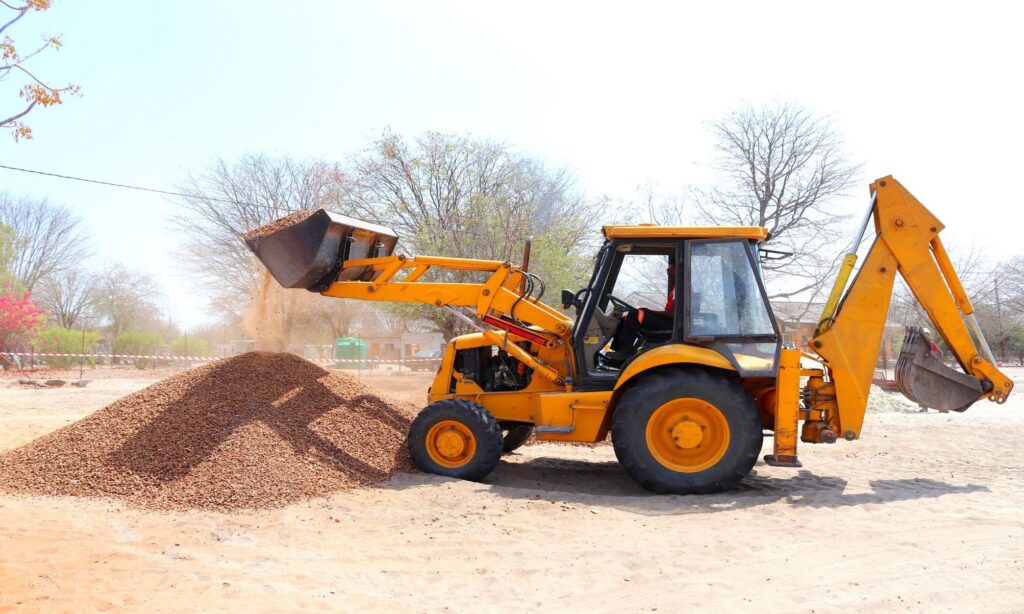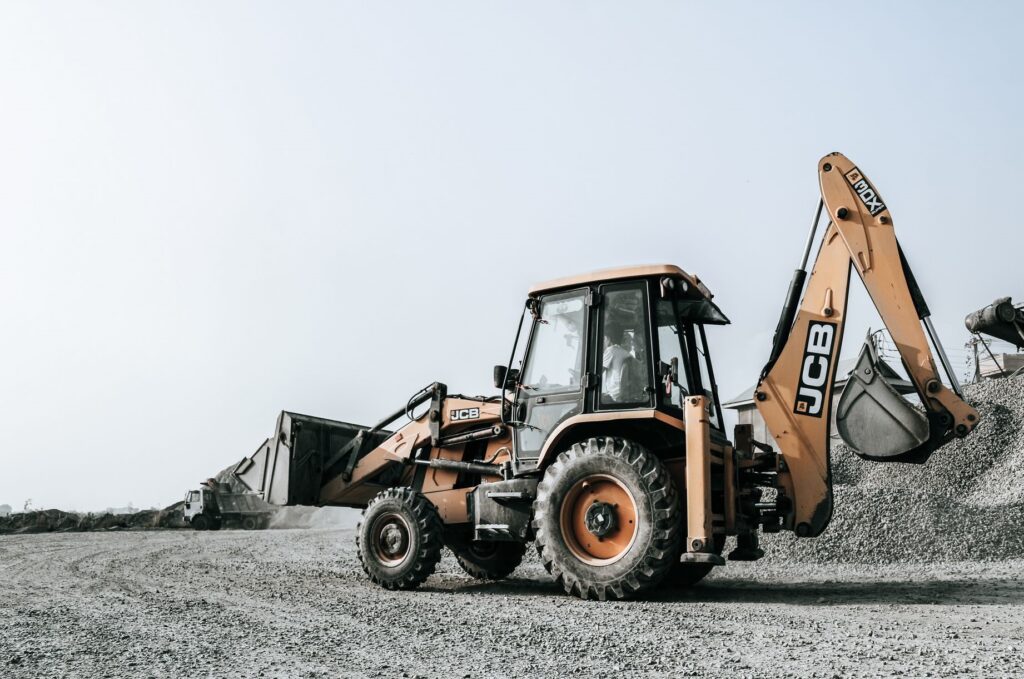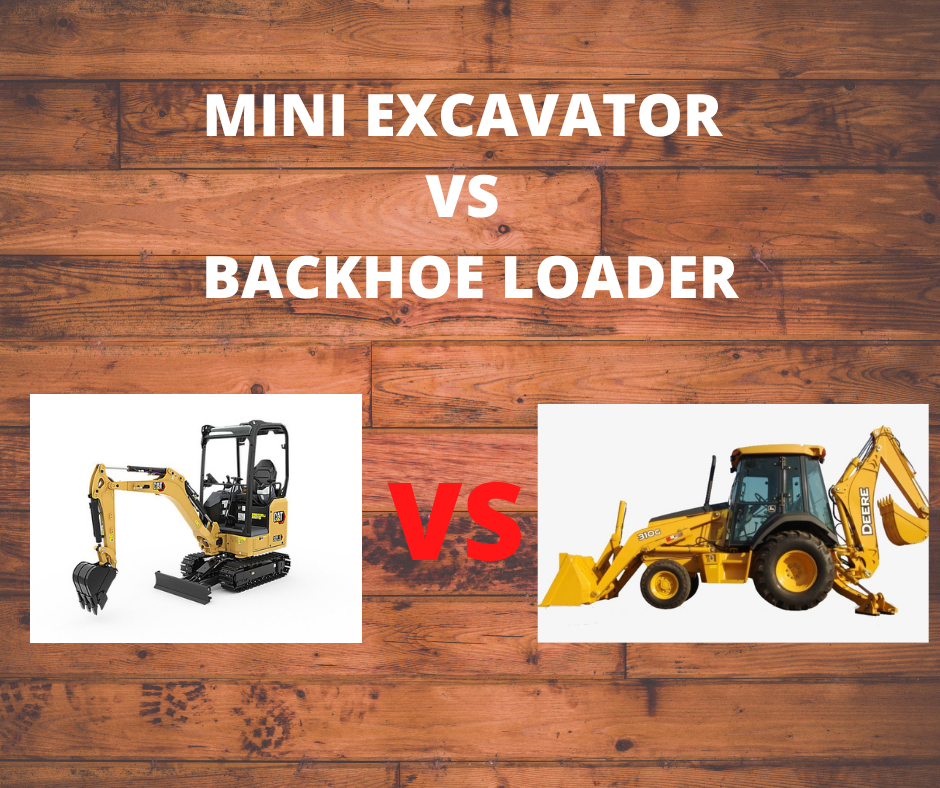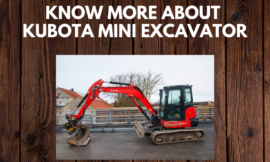When it comes to choosing a digger for small and medium construction jobs, they are generally two great options : a mini-excavator and a backhoe loader. This post Lists all the details of Mini-excavator vs Backhoe Loader
While they are both compact, mobile and pack a lot of power, they are still differences between them that make one more suitable for your projects than others.
To properly understand those differences is our aim here today. After reading this post, you’ll have no problem selecting which machine is best for your project.
What’s a Mini-excavator and its Uses
A mini-excavator is a general name for excavators that weigh less than 12,000 pounds. They are also called “Compact excavators”.
Compact excavators feature a boom, dipper, and a bucket which is powered by a hydraulic system. These mini diggers also have a cab for the operator which can rotate a full 360 degrees.

Due to their small size, compact excavators are very mobile and can be transported between work-sites very easily.
They are also good at working in project sites that have a lot of moving machines. This makes them perfect at small and medium-scale construction jobs.
Some of the most common uses of mini-excavators include :
Landscaping jobs :
Due to their small size and weight, mini-diggers are perfect for small landscaping jobs like backyard landscaping, tree clearing, etc.
They can fit into the tightest of spaces and their size makes them able to function well on soft, delicate terrain without damaging the terrain.
Installation of hot tubs and pools Mini-excavator vs Backhoe Loader
Forestry :
Compact excavators, despite their small size, are excellent machines for forestry projects. With a handful of attachments like brush-cutters, mulchers, shears, etc.
What small crawler excavators lack in power, they make up for it in versatility.
Roadside digging :
Small crawler excavator are also excellent at roadside digging. Their small size makes they will need only a little space.
Some mini-excavators can retract their under-carriage when working in confined spaces.
Waste recycling :
Small crawler excavators make use of continuous tracks and a backfill blade. This is very useful in landfill and recycling projects. compact excavators do well where their larger counterparts struggle because of weight.
For more on Mini Excavators Click Here
What’s a Backhoe Loader and its Uses
A backhoe loader is a hydraulically powered digging machine that features a bucket loader and a front loader on both ends of the machine.
It also features two smaller tires at the bucket end front loader on both ends of the machine. It also features two smaller tires at the bucket end and two larger tires on the front loader end.

The machine’s cabin can rotate 360 degrees while the front loader arm is only able to rotate 200 degrees. Backhoes come with either;
1) A center Pivot : where the backhoe is connected at the middle with two legs on either side of the mount to give it stability,
2) A side-shift mechanism : where the backhoe is attached to stable frame rails that are connected to the side and move vertically.
This enables the operator to work from the side without having to position.
Backhoes can be driven on public roads and this makes it easy for them to travel between job sites easily. They are also excellent at medium to large-scale excavation projects.
The front loader can be fitted with attachments like; a broom, plow, forklift, breakers, etc. which increases the versatility of a backhoe loader.
They are called “Backhoes” because the machine digs by pulling the bucket along the ground toward itself in a backward motion.
Some of the most common applications of backhoe loaders include :
Snow clearing :
Backhoes pack a lot of power and are still very mobile. This makes them perfect for clearing snow piles from roads.
They can be driven on roads which means that transporting them to the site will be both cheaper and easier.
Tree Planting :
transplanting trees demands that you dig holes that are 2-3 times larger than the rootball of the tree. Backhoes are excellent at the tree planting.
The front bucket loader can be used to lift trees without damaging the rootball which it needs.
Farming :
Backhoes are excellent for farming projects as they are very mobile and also very versatile. These are great for projects where multi-purpose machines are a must.
While they are very versatile, they also pack more power than small crawler excavators.
Mini-Excavator Attachments
The Mini-excavator vs Backhoe Loader attachments differ
Due to their size and maneuverability, mini excavators, when fitted with attachments can perform almost any construction task.
Examples of some common mini-excavator attachments and their function include :
Augers :
This attachment is used for more precise digging tasks like digging holes for trees, fence-posts, piers, etc. Augers can also be used to reach a digging area from the side. Augers costs between $1,000 – $3,000.
Clamps and Thumbs :
Clamps help to move materials that can’t be transported easily in a bucket. E.g rocks, tree stubs, etc.
Mulchers :
This attachment is used more commonly in agricultural jobs like land clearing, stump clearing, etc.
Some mulchers cost between $1,500 to $3,500 for smaller models and $9,000 to $20,000 for the larger models.
Shears :
Shears are used in demolition jobs to cut through metal wires and sheets.
It is also used to tear down steel and concrete structures. Shears costs around $1,500 to $3000 for small sizes and between $8,000 to $20,000.
Tilt-rotators :
This attachment is used to tilt the bucket or other attachments 45 degrees in either direction and also to rotate 360 degrees.
This helps the machine to work from different angles without needing to adjust the machine’s position every time.
Backhoe Attachments
With great power comes great responsibility, and backhoes do exactly that; take on more responsibility. With a handful of attachments, of course.

Interestingly, Small crawler excavators and backhoes share some similar attachments. Some of the most common examples of backhoe attachments include; drills, hammers, rippers, rakes, etc.
The front loader of the backhoe can be fitted with plows, forklifts, and brooms.
These machines can also serve as a crane by tying the straps of the object being lifted over the dipper.
More on Back Hoe Attachments Here
Mini-excavator vs Backhoe Loader
Small crawler excavators and backhoe loaders are both powerful digging machines that pack a lot of power despite being very mobile and versatile.
Some of the key differences between Small crawler excavators and backhoe loaders include :
Size :
Backhoe loaders are larger than small crawler excavators, usually weighing around — pounds. compact excavators on the other hand, generally weigh around 12,000 pounds.
Physical features :
A mini-excavator has a boom, dipper, and an attachment (e.g bucket, augers, plate compactors) as part of its workgroup. This workgroup collaborates during digging.
The workgroup is powered by hydraulics. A backhoe loader generally has two buckets. A larger digging bucket on the front end and a smaller front loader on the back end.
Rotation :
When it comes to the ability to rotate, small excavators and backhoe loaders vary. Mini-excavators can rotate the entire machine 360 degrees at a time while a backhoe can only rotate its loader arm 200 degrees.
However, backhoe loaders can rotate the operator’s cab 360 degrees so that the operator can see which attachment is being used.
Fuel Consumption :
Backhoe loaders are bigger and also pack more power than mini-excavators so it isn’t surprising that backhoe loaders consume more fuel than mini-excavators.
This is particularly useful to know when calculating the operating costs of the machine that you choose.
Initial costs :
Backhoe loaders due to their size, generally have a higher initial cost than mini-excavators. Mini-excavators on the other hand, have a higher transportation cost than backhoe loaders.
Mini-excavator or Backhoe Loader, Which is Better?
While both machines are quite nimble and pack a lot of power, your project requirements will be the ultimate decider of which machine you should go for.
To help make the decision easier, here are a few factors to consider :
Worksite terrain :
Worksites with a delicate terrain and/or difficult-to-reach places.
e.g indoor worksites, sites with noise regulations, etc will benefit from the small size of a mini-excavator. while worksites with tougher environments will fare better with a backhoe loader.
Exact project requirements :
As I said earlier, this is a major factor to consider when choosing what machine to use for your project. Both backhoes and small crawler excavators can handle similar tasks.
However, if your project would require heavy-duty work, or would require a lot of transportation across the worksite, then a backhoe would be your best bet.
Likewise, if your project doesn’t require heavy-duty work, or requires a lot of repetitive tasks, then a mini-excavator would be your best option.
Transportation and storage :
Mini-excavators are smaller and can fit inside buildings or storage facilities easily.
You’ll need a truck and trailer so you can move the mini-excavator from the storage facility and back which adds time to the project deadline.
Backhoes are larger and more difficult to store but they are easier to transport to and from the storage area and that may save time on the job compared to a mini-excavator.
Distance to be covered :
The amount of distance the project requires the machine to travel is also an important factor to consider. If you are working in a single area, then this is no problem.
However, if the project is spread across several locations, then a backhoe loader might be ideal as you can drive a backhoe loader 25mph on public roads.
A mini-excavator, on the other hand, will need to be hauled with a truck. This is usually straightforward.
Price and running costs :
The price of renting/buying the machine increases the budget significantly. Also, the running costs I.e fuel consumption add to the budget.
Take a careful look at your budget and project deadline to help you decide the machine that would best serve your budget and project requirements.
Should I get a Mini-excavator or a Backhoe Loader?
Getting a construction machine to buy or rent usually costs a pretty penny and so before getting a machine for your construction requirements.
It is important to ask a few questions that’ll help guide your buying decision
What is the size of my project :
Large projects would benefit from the extra power and size of a backhoe loader while smaller and medium scale projects can be handled properly by compact excavators.
What is the size of space I’m working with :
If your project location provides a lot of space at the worksite, then you can go for a loader machine. The machine’s power would be able to get more done than a mini-digger.
However, if your project site demands that the machine operators would be working with a lot of tight space, then a mini-excavator would be perfect.
They are good for working in tight nooks. Also, they are very mobile and can move around the worksite and other machinery and buildings easily.
Example of such jobs requiring tight space includes backyard landscaping and plumbing jobs.
What is my budget :
Knowing your exact budget gives you a sense of what machine you can most conveniently afford and how they will impact your project.
While compact excavators are generally cheaper than backhoe loaders, the latter packs more power.
Having a backhoe loader means that you can take on more work but it also means that you get to pay more upfront.
Multi-purpose or specialized machines :
Do you need a machine that can perform more than one task? Or are you looking for a machine to dedicate to a specific task?
While both small crawler excavators and loaders are versatile, backhoes have a wider range of versatility than mini-excavators. Also, backhoes pack a lot more power.
Price of Mini Excavators and Backhoe Loaders
The price comparision of Mini-excavator vs Backhoe Loader
The price of compact excavators and backhoes generally depends on several factors which include; the machine’s dig depth, horsepower, and machine size.
However, the market average price of a mini-excavator is :
- small crawler excavators with a dig depth 5’ to 7’ feet and 10-20 horsepower costs as much as $25, 000.
- compact excavators with a dig-depth of 10 feet and average horsepower 20-30 costs around $35, 000 – $42, 000.
- compact excavators with a dig-depth of 12’ feet or more and an average horsepower of 40+ costs around $55, 000 – $65, 000.
The market average price of backhoe loaders generally include :
- Backhoe loaders with a dig-depth of 6 feet cost around $12,000 – $18,000.
- Backhoe loaders with a dig-depth depth of 10 feet costs around $20,000 – $35, 000.
- Backhoes with a dig depth of 14 feet and an average horsepower of 80 cost between $50, 000 to $80,000.
- Backhoe loaders with a dig-depth of 16 feet costs around $70,000 to $110,000.
- Backhoe loaders with a dig-depth of 18 feet above costs between $110,000 to $150,000.
Some other factors that may affect the price of mini-excavators and backhoe loaders include upgrades, optional features like automatic transmission, etc.
Conclusion of Mini-excavator vs Backhoe Loader
Compact excavators and Backhoe loaders are both very powerful when it comes to digging. Their added mobility and versatility make them very desirable in almost any kind of construction project.
However, due to price and space constraints, you need to be careful to choose the machine best suited to your project requirements.
Luckily, this post is at your service. Go through it to give you a sense of what to consider and the kind of questions to ask before you go ahead and make any purchases.




